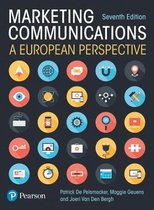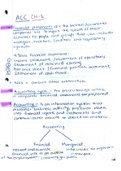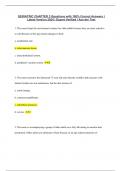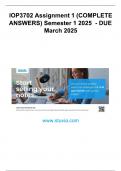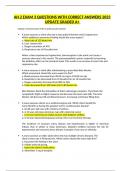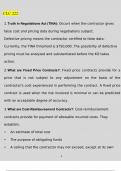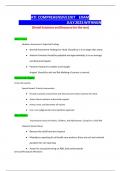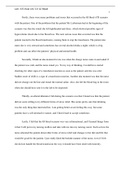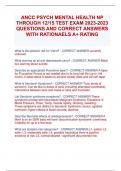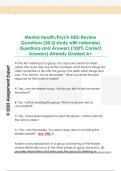7th edition, chapters 3, 4, 6, 12
Chapter 3: How marketing communication works
Hierarchy-of-effects models
Hierarchy-of-effects models assumes that things
have to happen in a certain order, implying that the
earlier effects form necessary conditions in order for
the later effects to occur.
Three stages traditionally:
Cognitive (think) Affective (feel) Behavioural (do)
• Engage mental • Emotional and • Undertake action
processes --> evaluative resposns (e.g. buying)
awereness + occur
knowledge
But…
Low-involvement hierarchy-of-effects model according to which consumers, after frequent
exposure to marketing messages, might buy the product, and decide afterwards how they
feel about it (cognitive–conative–affective hierarchy)
Experiential hierarchy-of-effects model in which consumers’ affective responses towards
a product lead them to buy it and, if necessary, they reflect on it later (affective–conative–
cognitive sequence).
Foote–Cone–Belding (FCB) grid
High–low involvement vs think–feel dimension.
• Involvement - the importance people
attach to a product or a buying decision,
the extent of thinking and the level of
perceived risk.
• Think–feel dimension - a continuum
reflecting to what extent a decision is
made on a cognitive vs affective basis.
Rossiter–Percy grid
High–low involvement vs fulfilling a transformational or informational buying motive.
• Transformational buying motives - positive motivations (e.g. sensory gratification,
social approval or intellectual stimulation. E.g. ice cream, cosmetics and perfume).
• Informational buying motives - reducing or reversing negative motivations (e.g.
solving or avoiding a problem, or normal depletion. E.g. detergents, babies’ nappies
and insurance products).
The quadrants are to classify people and not product (categories). A car can be in every
quadrant, depending on how the consumer thinks-feels about it. positioning tool!
Advantages:
• Provides framework for communication objectives and campaign effectiveness
measurement
1
,Disadvantages:
• Lacking on that individuals go through all stages
• No interaction between stages.
Attitude formation and change
Attitude - a person’s overall evaluation of an object, a product, a
person, an organisation, an ad, etc. In this view, an attitude towards
a particular brand (Ab) can be considered as a measure of how much a
person likes or dislikes the brand, or of the extent to which he or she holds a
favourable or unfavourable view of it.
→ Marketing communication goal: change attitude in favour of the brand, by
focussing on one of the three elements
Affective; love Timberland. Cognitive; durable and convenient. Behavioural: buy them
Communications models regarding attitude formation and attitude change can be classified
along two dimensions (dual process theories):
• The way attitudes are formed – primarily cognitive, affective, or behavioural
• The level of elaboration of a message, or central-route versus peripheral-route
processing
Separate (or different type of processing):
• System 2: information processing through unconscious, rapid, automatic, low
cognitive capacity (intuitive)
• System 1: information processing through conscious, slow, deliberative, high
cognitive resources (rational)
Elaboration Likelihood Model (ELM) – explain and predicting consumer responses to MC.
Central or peripheral processing depending on how optimal processing conditions are.
Processing conditions:
• Motivation = a willingness to engage in behaviour, make decisions, pay attention,
process information, etc. Influenced by consumer needs and goals.
o Consumer needs can be categorised as functional, symbolic, or hedonic
▪ Functional: informational motivation
▪ Symbolic: how we see ourselves and how we would like to be
perceived by others
▪ Hedonic: desires for sensory pleasure
o Consumer needs/goals as
▪ Approach/promotion (communicate positive outcomes)
▪ Avoidance/prevention goals (emphasize negative outcomes)
• Ability = the resources needed to achieve a particular goal
• Opportunity = the extent to which the situation enables a person to obtain the goal
set
It is not so much the MAO factors, but consumers’ goals that might determine whether
consumers rely on the substance of the message (i.e. the strength of the claims, the
compellingness of the product attributes, etc.) to form a judgement or on their affective
responses (i.e. ad-evoked feelings, aesthetic of the product design, charisma of the
endorser, etc.). Individuals focus on ideals they consider affective information as more
relevant and, as a consequence, are more likely to base their evaluation on affect.
2
,How exactly the message substance or affective responses are processed is likely to depend
on consumers’ elaboration likelihood.
High elaboration likelihood, cognitive attitude formation
Multiple attribute models
• Expectancy–Value model / Fishbein model
o Relevant product attributes
o The extent to which one believes the brand possesses these attributes
o The evaluation of these attributes (how good/bad)
Brand attitude is represented by the weighted sum of the products of brand beliefs
and attribute evaluations:
3
, • Theory of Reasoned Action (TORA)
Developed to provide a link between attitude
and behavioural intention. Not only by
attitudes, but also by the subjective norm =
comprises the belief one holds regarding
what different reference groups consider as
socially desirable behaviour, weighted by
the consumer’s need or willingness to
behave according to the norms of the particular
reference group (social sensitiveness).
• Theory of Planned Behaviour (TPB)
Extent above intention to but → and actually buy (resources available). Behavioural
control as perceived by the consumer is more predictive of behaviour than actual
behavioural control. Perceived behavioural control (PBC) can be defined as ‘the
perceived ease or difficulty of performing the behaviour and it is assumed to reflect
past experience as well as anticipated impediments and obstacles’ (e.g. feeling
more/less confident during a foreign language course while both highly motivated).
• Self-generated persuasion
The consumer is not persuaded by strong brand arguments, but by his or
her own thoughts, arguments or imagined consequences. Combine message
information with own experience/knowledge and tries to imagine him- or herself
consuming. Sometimes consumers even come up with new product uses → creates
strong brand belief
Low elaboration likelihood, cognitive attitude formation
Heuristic evaluation = make inferences
on the basis of the cue in order to form a
cognitively based attitude or based on ad
characteristics (cues ad → heuristic to
evaluate quality message → form
general evaluation of the brand
advertised) satisfactory or acceptable
brand choice.
4

